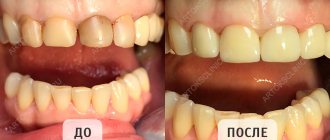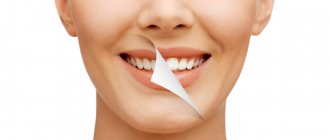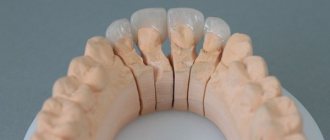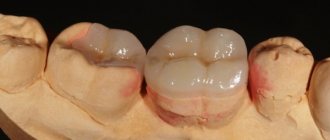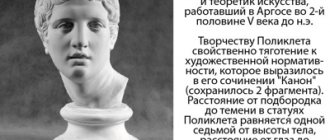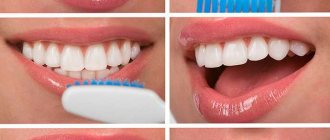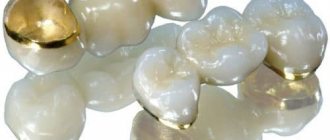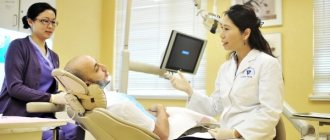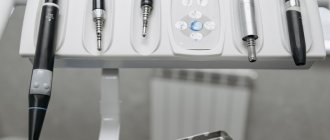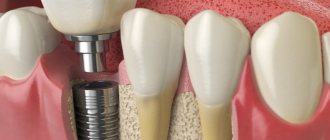Typically, the prosthetic procedure takes quite a long time. Most of it is spent on making crowns, inlays or veneers. Therefore, the patient has to experience discomfort due to the treated teeth for several days.
Cerec allows you to restore teeth directly on the day of visiting the doctors of the President Dental Center. The waiting time will be no more than three hours. The restorations carried out will be very accurate and durable.
Review of CEREC technology (“Cerec”) – features, why it is needed, advantages and disadvantages
Article navigation
- CEREC technology – what is it?
- Application area
- What is included in the CEREC complex
- Stages of making prostheses
- Benefits of technology
- What are the disadvantages
- Cost of CEREC restorations in Moscow and other cities
Question for a specialist
Modern computer technologies are actively used in all spheres of our lives. And medicine is no exception. In dentistry, they are needed for dental treatment, implantation, and also the creation of various dentures. Moreover, such technologies are capable of producing not only very high-quality prostheses, but also doing it very quickly. For example, Cerec crowns and CEREC inlays and veneers can be produced in just a few minutes. In the next article we will tell you what the CEREC system is, its scope of application, its advantages and the cost of restorations.
Aesthetic prosthetics.
Uneven chips, unattractive enamel color, damaged crowns - all this can significantly ruin your smile. What previously could only be afforded by aristocrats and movie stars is now available to many members of the middle class.
In this category of prosthetics, veneers remain the most popular - porcelain overlays on the outer part of the front teeth. Before the introduction of Cerec technology, this technique periodically failed: if the veneer did not fit accurately, chips or cracks appeared in the ceramic coating. Now, with the help of digital modeling, the installation of veneers and crowns becomes 100% airtight. This is confirmed by official reviews of people who underwent restoration.
This is interesting! Statistics of completed restorations confirm the fact that ceramic crown restoration using the Cerec system has a durability of more than 10-15 years, and the percentage of modifications and corrections ranges from 0.5-2.5%.
CEREC technology – what is it?
CEREC technology is the creation of various dentures from high-quality ceramics and zirconium dioxide using special programs and modern computerized milling equipment. In its full form, the name CEREC stands for “Chairside Economical Restorations of Esthetic Ceramic” and means “economical and aesthetic ceramic prosthetics.”
The Cerek complex was developed in the 80s of the twentieth century in Zurich, and is currently produced by the dental concern Dentsply Sirona from the USA. This is a very large enterprise that produces everything for the field of dentistry - filling materials, treatment instruments, orthodontic aligners (silicone “braces”), implants of the brands Astra Tech, Ankylos, XiVE.
Only until December 25 South Korean implant Osstem - from 18,500 rubles.
Hurry up to sign up for a free consultation and lock in promotional prices.
Call now or request a call
Opening hours: 24 hours a day - seven days a week
What will you get by choosing Cerek?
Excellent technology in the hands of an experienced specialist gives a feeling of confidence and often exceeds patient expectations. I encounter this reaction from patients regularly. Saving time, and this minus one or two visits and the journey there and back gives you hours of your life. There is no discomfort of waiting for a second visit to the dentist. The natural appearance returns patients the desire to smile, and the precision of manufacturing and the strength of the adhesive fixation will make it possible to preserve the tooth for many years. But the best thing the patient gets is the opportunity to forget about the problem in a few hours.
Scope of application of the CEREC system
- creating recovery tabs,
- production of ceramic and zirconium crowns and bridges CEREC: both on natural teeth and on implants. Moreover, crowns on implants can be created for both cement and screw fixation,
- production of veneers: thin overlays on the front surface of teeth,
- creation of individual abutments for dental implants,
- creation of surgical templates for CEREC Guide 2 implantation,
- optical digital impressions for planning treatment with aligners: orthodontic devices for bite correction.
What is included in the CEREC complex
All components of the CEREC system are interconnected, which facilitates and speeds up the process of dental prosthetics in any individual case. Moreover, the devices can be connected both to equipment in the orthopedic dentist’s office and to equipment elsewhere in the clinic - for example, in a dental laboratory (where more complex dentures are made). All patient data is integrated into a secure storage center (Hub), from where it can be sent to robotic machines or ovens. But first things first.
Omnicam 3D oral scanner
The compact camera-scanner CEREC Omnicam allows you to obtain the most accurate digital impressions of both jaws in natural color in just 2 minutes. The scanner does not require the patient to endure the uncomfortable procedure of taking classical impressions using a special mass. And the dentist does not need to prepare the teeth for scanning by covering them with powder.
Software for modeling prostheses and microprostheses
A very well-developed and, at the same time, understandable product for a dentist, which is based on artificial intelligence. The program models the restoration so well (a unique feature of Biojaw) based on the digital impression data that it can be immediately sent for production. And in most cases, you don't even need to add any manual additions to the virtual model. And the Shade Detection function suggests the optimal color of the denture that matches the shade of the patient’s teeth.
Grinding and milling equipment
CEREC working machines, receiving data via a network from a virtual planner, mill and grind the prosthesis in full accordance with the 3D model. This ensures precise adherence to fissures and cusps, cutting edges and grooves of the artificial part of the tooth. Restorations made from dense and difficult to process zirconium dioxide can be produced as quickly as ceramic ones - i.e. for 1 visit to the clinic. The time the machine operates to create a single restoration ranges from 4 to 12 minutes.
In total, Cerek has 3 grinding and milling machines that create products with an accuracy of up to 25 microns - and this ensures an extremely tight fit of the prosthesis on the support, without gaps or air cavities into which bacteria can penetrate. Moreover, the machines produce not only prosthetics, but also surgical templates, which simplify the installation of implants and allow them to be implanted in accordance with the virtual model.
SpeedFire oven
According to the manufacturer, SpeedFire from Cerek is a unique and only furnace in the world for the manufacture of prostheses, in which two processes can take place:
- sintering (baking),
- glazing: when the prosthesis is additionally coated with a layer of ceramics and again placed in the oven, for a more aesthetic appearance and to add shine.
The SpeedFire induction oven has a compact size and a very fast baking time - just 10-15 minutes is enough and the crown, veneer or inlay is ready. Not only materials from CEREC (Zirconia blocks), but also glass ceramics Suprinity PC from VITA Zahnfabric and IPS e.max from Ivoclar Vivadent, for example, are compatible with this oven.
Materials for prosthetics
produces many materials for dental prosthetics, which are worth considering in more detail:
- zirconium dioxide Zirconia blocks: suitable for processing in the dentist's office. This durable and aesthetic material is used to create thin-walled crowns, long-lasting bridges,
- zirconium dioxide blocks for prosthetics on implants: Zirconia Meso – for crowns fixed to implants with screws, InCoris Zi meso – for individual abutments,
- feldspathic ceramics in natural enamel shades: CEREC Blocs C blocks – for full-size crowns, restorative inlays and onlays (veneers), Blocs C PC – only for the production of crowns, Blocs C In – for crowns with the highest aesthetics (in the smile area),
- metal blocks and discs made of cobalt-chromium alloy inCoris CC: for metal prostheses or their bases.
In addition to our own materials, as well as the already mentioned VITA Zahnfabric and Ivoclar Vivadent, materials from 3M ESPE, Merz Dental, COLTENE, GC, Kuraray Noritake, Shofu can be used for processing with CEREC systems.
OPERATIVE PROSTHETICS WITH ACRYLIC PROSTHETICS - from RUR 180,000.
Re-prosthetics with an acrylic bridge on a metal frame (all included) up to 12 units.
Save RUR 30,000. Call now or request a call
That is, this complex as a whole is not just unique, but also universal.
“Ceramic crowns are just lovely, they look much better than metal-ceramics. And I had a not very pleasant experience with it, when the gums began to appear blue-violet. Moreover, now everything is done super-quickly! The last time, my dentist placed a Cerek ceramic crown in one appointment. And I sat and watched as it was cut out with special blades in the device. Fascinating..."
Anna P., review from otzovik.com
Comparative review of existing models
Manufacturer Nicetech-CNC (Korea)
Milling machine Spinel 5X Super (3kW-5 axes)
Milling materials:
- Zirconium Oxide (98.5 mm), Cobalt Chrome, Titanium, PMMA, WAX, E.max, Trinia, Peek, Hybrid Ceramics, Pre-mill abutments, etc.
- Making a metal abutment from 17 minutes to 45 minutes depending on the quality of the surface
- Making a zirconium crown with full anatomy takes about 20 minutes
- Includes holder for 10 pieces of Pre-Mill.
- 5 replaceable block holders
- Wet and dry milling of materials
- Maximum spindle speed - 60,000 rpm
- Spindle power 2.2 kW, peak reaches 3 kW
- Water cooling of the spindle with antifreeze (an advantage over air). Constant spindle heating temperature - 25-28 degrees
- Automatic tool change – 10 cutters
- 5 axes
- Dimensions LxWxH – 640x640x180
- Weight 350 kg eliminates any vibration when milling metal
- Manufacturing of abutments with high precision
- Reinforced servo guides along XYZ axes
- New servo control system from PANASONIC
- A large built-in Touch screen with a control system is already included in the price of the machine
- The camera configuration has been changed and increased, which makes the operator’s work more convenient
- Improved air supply system (automatic dryer built-in) does not require a compressor with a dryer
- Improved spindle water cooling system
- A function for calculating the work of cutters (number of runs) has been introduced.
- UNIQUE WATER COOLING OF THE SPINDLE INCREASES ITS LIFETIME BY 3 TIMES
In terms of characteristics and a very competitive price, today this manufacturer is a leader in working with metal and zirconium at the highest level. Video: Milling a titanium abutment (~ 19 minutes)
Video: milling a 98.5 mm CoCr disc
Video: Milling a 98.5 mm zirconium disc
Video: milling ceramic blocks
Milling a titanium disc on Spinel NX5
Manufacturer Robot Design in collaboration with Maxx Digm (Korea)
The most powerful machine in its class with minimal dimensions, compact for the production of titanium abutments, cobalt-chrome milling, etc.
- Model DS-4WA Korea
- Controller and Motor Built-in PC (10.1 inch touch screen), AC servo motor
- Operating range index A = ± 180 degrees
- Shank diameter: 6mm, ATC 8 tools
- High frequency spindle, S1: 1400W, max. 2700 W, 60,000 rpm
- Milling materials: Metal, titanium blank for abutments, premilla and hybrid ceramics, zirconium, wax, PMMA
- Number of axes - 4
- Milling type Wet
- Granite base is an indicator of vibration resistance and high precision milling of solid material
- Dimensions and weight: 500 x 725 x 712mm, 110kg
Video of making titanium abutments on the DS200-WA machine
Manufacturer DOF (Korea)
Stages of manufacturing prostheses with the CEREC complex
Dental prosthetics with the Cerek complex involves several stages:
- choosing the type of prosthesis,
- preparation of teeth: sanitation of the oral cavity and grinding,
- jaw scanning,
- creating a virtual image of the future prosthesis: crown, bridge, veneer, restorative inlay,
- milling the product according to the model,
- baking and glazing,
- fitting and installation of the prosthesis.
And all this – in one visit to the doctor! You come in with a badly damaged tooth, caries, a fallen filling, darkened and non-whitening enamel on your front teeth, and you leave the dentist with a new smile. Moreover, she looks very natural and natural.
List of modeling programs to help the dentist
There are many CAD systems for 3D design of teeth for the purpose of their subsequent manufacture. Most Popular:
- Denta Pro;
- Dentist+;
- Denta lAccord;
- Dental Cloud;
- ClinicIQ;
- QStoma;
- Adenta;
- Dental4Windows;
- iStom;
- Infodent;
- IDENT;
- DENT;
- Dental-Soft;
- 1C: Dental clinic.
But technological progress has a positive effect on the development and implementation of new software, and therefore AutoCAD, ZWCAD and other design programs and visualizers are being improved, developed and become reliable assistants for dentists and dental technicians.
Benefits of CEREC technology
- the patient does not need to walk with a temporary prosthesis or filling,
- reduction of treatment time: in order to create dentures manually, a dental technician will need at least 2-3 days, then the mandatory stage of fitting and adjustment of the product will follow. This means that it will be possible to get new teeth no earlier than in 5-6 days. CEREC machines take just a few hours from start to finish to create the perfect prosthesis, ready for installation,
- the accuracy of creating the design and its durability when worn: when creating a virtual model, the structure of the patient’s jaw, bite, and the location of adjacent and opposite teeth (antagonists) are taken into account. That is why the product turns out to be ideal, without causing discomfort or unpleasant sensations. In addition, the prosthesis fits very tightly to the treated tooth surface, which eliminates the possibility of caries forming under the prosthesis,
- no need to try on the prosthesis,
- Only high-quality materials are used: ceramics, porcelain, glass ceramics, zirconium dioxide,
- There is no need to repeatedly use anesthesia for prosthetics.
According to a sociological survey1 conducted in 2015 among patients of dental clinics, 85% of respondents would like to receive dentures for their teeth immediately during the first visit, without waiting several days. And almost 70% of patients expressed the opinion that they are ready to choose dentistry that is more distant from them, but one where they can get dentures immediately.
CEREC technology in dental prosthetics can significantly save patients’ precious time, as well as relieve psychological discomfort associated with missing teeth.
Advantages of prosthetics using the Cerek system in dentistry
More and more clinics are choosing Cerec technology due to its advantages, which make life easier for the patient and provide a guarantee of the quality of the doctor’s work.
- Time.
The most important advantage of the system. Instead of two or three visits, wearing a plastic temporary denture, or waiting for a new crown with a “hole” in the mouth, the patient receives the same-day restoration in just a couple of hours. - Accuracy.
In the traditional production of dentures, a large percentage of the probability of error is the human factor - even the most qualified specialist can make a mistake in the calculations, and the loss of just one tenth of a millimeter threatens a loose fit of the crown or a violation of the closure of the teeth. Digital modeling and an automatic machine guarantee the accuracy of calculations and the production of the ideal prosthesis, and the virtual planner allows you to see the future result at an early stage. - Comfort.
There is no need to use impression mass, powder, paper, or force the patient to bite the plaster and wait for it to harden with his mouth open. Digital impression taking takes less than a minute. - Long service life.
Due to the accuracy of calculations, jewelry turning and high-quality baking, dentures of the Cerec system ensure a tight fit and structural strength - they will last much longer than traditional products. - Aesthetics.
Computer modeling allows you to choose a color that fully matches the patient’s enamel, as well as work out all the tubercles and grooves - the dentures do not differ from the patient’s natural teeth, they look natural and aesthetically pleasing. - Quality.
As a rule, specialists use materials recommended by the manufacturer for their work. Blocks of zirconium dioxide and Cerec ceramics are ideal for the grinding machine and furnace of the complex; in addition, all materials are certified and quality tested, do not cause allergies and have a wide range of colors for choosing the optimal shade of the future prosthesis.
Cerek technology in dentistry is an innovative, reliable and high-quality prosthetic system. However, the cost of equipment for the entire complex is quite high, and in order to work with the system, the doctor must undergo training. Therefore, the cost of the procedure using this technology is also slightly higher than traditional prosthetics, because the cost item already includes expenses for hardware, materials and training. In addition, not all clinics can afford such expenses.
Therefore, if you have been offered Cerec prosthetics in dentistry, you can trust this clinic, because they spare no expense and time for the comfort of patients, and the excess costs of the procedure are fully covered by the quality, reliability and durability of the products.
What are the disadvantages
The only drawback is the high cost of the equipment and the need for the dentist to undergo training at the manufacturer (in person or online). Therefore, such products cannot be offered in every dentistry, but only where they spare no time and money for the most modern treatment and patient comfort.
The disadvantages of a portable oven include the not very large size of the baking box - no more than 3 single crowns or a bridge of 3 crowns can fit there. But simultaneous production of a larger number of crowns using the CEREC system or extended bridges is also possible - but in a laboratory setting, using other equipment - and this will take a little longer.
How it works
It all starts with a consultation. If you are unfamiliar with either crowns or Cerec, your doctor will explain all stages of treatment and answer your questions. Then, after administering the anesthetic, the tooth is given a certain shape using a diamond bur. An intraoral 3D camera scans the required areas of the dentition, and the data is transferred to the program. Digital models of the jaws are created, on which the computer recreates the tooth, and the doctor corrects minor individual features. Via Wi-Fi, the information goes to the milling unit, which grinds out an exact copy from a ceramic block. The finished crown is given a glossy finish; if necessary, it can be individualized using special coloring with ceramic dyes and glazes. The tooth in the oral cavity is carefully isolated from saliva, covered with adhesive cement and the crown is installed in its place. For the patient, the process is not tiring, and for digital technology lovers it is even interesting.
Cost of CEREC restorations in Moscow and other cities
Prices for crowns, inlays and CEREC veneers in Moscow are usually the same as in other cities of the country. The price includes not only the cost of the material and the number of restorations, but also the rental of premises, the markup for the work of a dental laboratory (if the prosthesis will be made in it, and dentistry does not have its own laboratory). On average, the cost of a ceramic crown or inlay will be 15-18 thousand rubles, and a zirconium dioxide crown or veneer will cost 25-30 thousand.
- According to the company Exevia (Germany), which conducts marketing research of medical and pharmaceutical equipment.
Author: Vasiliev A. A. (Thank you for your help in writing the article and the information provided)
Valentina Vasilievna, Moscow
The old crown on the tooth began to crumble. Or rather, it’s not that old - it’s only a year and a half old, but apparently it was installed poorly. I imagined that grinding, impressions, fittings, and endless trips to the dentist would begin again - and I decided to look for new solutions. The Cerec method worked for me. I set aside 1 day and came to the Dental clinic. They immediately removed the unusable prosthesis, prepared the tooth - they ground it just a little, and took impressions with a scanner. While I was reading a magazine, I watched a movie on my phone in the foyer - and that’s it, they called for a new ceramic crown to be installed. The color matched perfectly. Very comfortable. Thank you.
